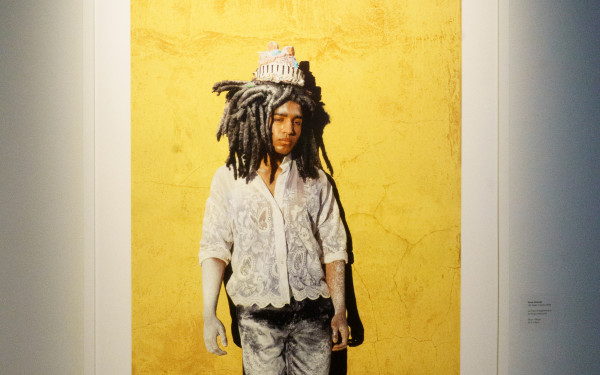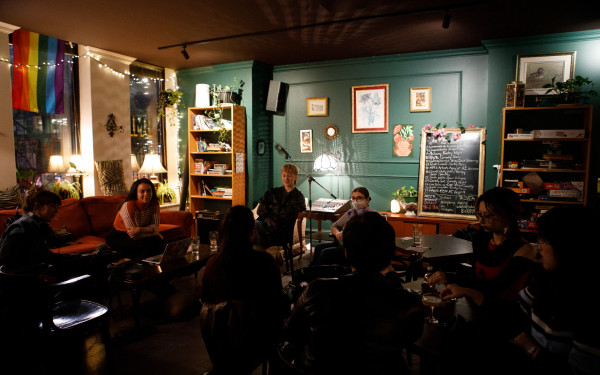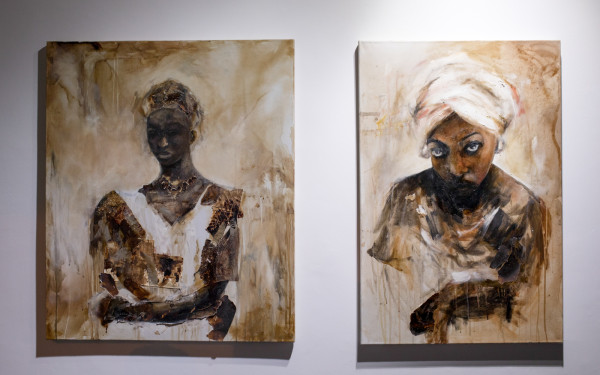Making Their Mark: Two of Concordia’s Finest Artists
Daniel Itiose and Mel Arsenault Look to the Future as They Approach the End of Their Time as Concordia Students
Daniel Itiose’s art is raw and real. It captures every aspect of its subject’s face, down to the tiniest detail, and brings it to the forefront.
“It’s about my appreciation for the way nature works. I just explore the human condition,” said the hyperrealist, who is set to graduate from Concordia with a bachelor of fine arts at the end of the fall semester.
His style, that jumps out so viscerally at the viewer, derives itself from an appreciation of the natural beauty that exists in human beings.
As raw and emotional or supposedly imperfect it may be, the natural look is beautiful, explained Itiose.
Blemishes and lines can shine in his works as he strives to depict people as they truly are.
When he arrived to Canada from Nigeria at age 12, Itiose was shocked to see how much people hated their natural looks and wanted to look perfect. He couldn’t understand the dislike for “nature’s design.”
“That pushed me more into the realm of hyperrealism in terms of wanting to get people to accept these so-called flaws and these things about their faces that make them human,” he said.
A style like his certainly takes drive. Perfecting that exact, lifelike style is a long process.
One of his most recent works took Itiose approximately 300 hours. All of that while taking courses and maintaining a full-time job.
_(1)_900_1348_90.jpg)
But the work that goes into pieces like his is just another reason that Itiose loves hyperrealism as a style. The work shows.
He appreciates the work that is so evident in the piece as much as he enjoys the final result.
He’s been able to enjoy the results of his process and work as an artist this year in particular.
He exhibited pieces more than once for the very first time as his works Catharis and Occulus were shown at the Visual Arts Visuels Gallery on campus, and through the art collective Antes, something Itiose felt brought a new level of visibility to his work.
The success and growth of the last year has him focused on a new goal as an artist: efficiency.
“This year was basically me trying to figure out ways to get it done, I wouldn’t say quicker, but more efficiently […] getting more comfortable and just, on the whole, getting better at what I do,” Itiose explained.
As he ventures past Concordia, he’s already set himself the goal of creating 10 to 12 new hyperrealist works in 2020.
His excitement to be finishing his university journey and continue pushing his own limitations and boundaries is clear.
“It’s more of a gut feeling, I put things together […] when I’m happy, when there’s harmony—which for me is beauty—in the installation, then I stop.”
— Mel Arsenault
Visual artist Mel Arsenault creates stories where everything begins with clay.
The compositions of her installations make a narrative, and it’s up to each viewer to interpret and find its meaning.
“It’s more of a gut feeling, I put things together […] when I’m happy, when there’s harmony—which for me is beauty—in the installation, then I stop,” she said, adding that she can find harmony anywhere, even in a piece of trash on the ground.
Specializing in ceramics, Arsenault is entering the second year of her master’s degree at Concordia.
She works with different types of clay like stoneware, porcelain, terracotta, and makes the coloured glaze herself using pure mineral pigments in powder form.
_900_600_90.jpg)
Here is ceramics in a nutshell: what differentiates clays from one another is their level of purity, she explained.
Porcelain, for example, is pure because it comes from the top of the mountain, that’s why it’s white; wind, water, iron and dirt have not contaminated it.
Older clays take other particles with them and get a darker brownish shade. Once clay is fired in the kiln, it becomes ceramic.
She explained that ceramics is “a really demanding medium,” with no room for error. The precise timing between each drying stage is crucial to the successful outcome of the artwork.
Her background in woodworking inches into her pieces as she creates mini representations of furniture in her compositions.
Longing to escape the tediousness of her desk job, Arsenault took up painting as a pastime and then decided to pursue a degree.
Through her bachelor of fine arts in Concordia’s painting and drawing program, she discovered ceramics and her artistic focus completely shifted.
“It was clear from the beginning that I could express myself better with ceramics than on a flat canvas,” she said.
A dozen or so of her pieces were exhibited at the VAV Gallery in a show organized by Art Souterrain the spring of 2018. “It brought me to another level,” she said, as more and more people gained interest in her work.
Discussing her current projects, Arsenault said she’s making bigger pieces.
Inspired to create larger pieces after a residency in Denmark, one of her most recent projects, a work in progress called The Pot of Pots, is an assemblage of stacked pots, showcasing her skills in throwing, the term used for working on the potter’s wheel.
“Ceramics is amazing, it’s really fun, and it’s endless.”

_copy_900_600_90.jpg)
_600_832_s.png)




